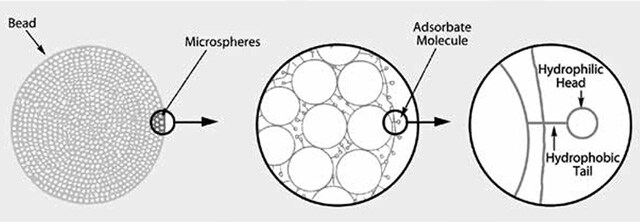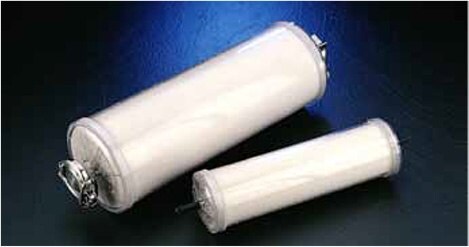Removal of Detergents from Biological Product Matrices
J. Patrick Myers
US Reporter Volume 30.3
Most modern biopharmaceutical research and manufacturing requires the use of one or more detergents. Detergents are amphipathic molecules having both hydrophilic and hydrophobic properties. These unique properties are used to alter the interactions between biological molecules in aqueous solutions.
Detergents are organized into broad classes based on the nature of the polar, hydrophilic part of the molecule. The classes include ionic (further broken down into negatively charged anionic and positively charged cationic), nonionic (uncharged), and zwitterionic (having both positively and negatively charged groups, but with a net charge of zero). Under the proper conditions, detergents form micelles in water.
A micelle is a three dimensional structure formed when the concentration of a detergent increases in water beyond the amount that can form a monolayer on the surface. Micelles are typically spheres in which the hydrophobic part of the detergent molecules associate with each other, while the hydrophilic parts of the molecules contact the water[1]. The number of detergent molecules per micelle (aggregation number) and the range of detergent concentration above which micelles form (called the critical micelle concentration, CMC) are properties specific to each particular detergent. The critical micelle temperature (CMT) is the lowest temperature at which micelles can form. Below the CMT, detergent molecules exist in a crystalline form in solution and are not effective. Above the CMT, detergents form micelles and become effective in disrupting lipid-lipid interactions.
The molecules that make up biological membranes are also amphipathic2. They are made up of polar “heads” attached to lipophilic, hydrophobic “tails”. Stable membranes are formed when the “tails” of the molecules associate with each other in a bilayer sheet-like arrangement, leaving the polar “heads” to contact the polar, aqueous milieu on both sides of the membrane. Additional molecules embedded in the lipid bi-layer, including proteins and cholesterol, are important to the flexibility and function of the membrane. The formation of detergent micelles is important because it allows the dispersion of water-insoluble, hydrophobic compounds into aqueous solutions. It also allows the disruption of biological membranes and extraction of proteins. The disintegration of membranes occurs by disrupting the lipid-lipid and lipid-protein interactions in the membrane.
In biological research and biopharmaceutical manufacturing, detergents are used for many purposes. They include stabilizing proteins and nucleic acids during electrophoresis; dissolving membrane proteins; prevention of nonspecific binding in affinity purification and immunoassay procedures; control of protein crystallization; and disruption of cell membranes to release membrane bound and intracellular proteins.
In biopharmaceutical production, the detergent must be removed from the product during downstream processing activities3,4,5. Methods for removing detergents include gel filtration, size exclusion, dialysis, and hydrophobic adsorption chromatography. Data presented in Tables 1 and 2 demonstrate that pre-packed, sterile, endotoxin-free Porozorb™ cartridges can also be used to effectively remove detergents and other nonpolar, hydrophobic materials from biological preparations.
Table 1 shows the capacity of various Porozorb cartridges for several common detergents used in biopharmaceutical applications. Table 2 demonstrates the time required to reduce a 0.1% concentration of one of those detergents, Triton® X-100, in a 10 liter solution to below detectable levels.
The AMBERLITE® XAD-4 resin (Figure 1) used in Porozorb™ cartridges is a proven technology that is highly effective in removing various detergents from cell culture media in biopharmaceutical applications, such as vaccine production.

Figure 1. Structure of Hydrophobic Macroreticular Resin Bead
Porozorb cartridges (Figure 2) are disposable, and available in sizes appropriate for analytical to process scale purification schemes.

Figure 2. Disposable Porozorb Cartridges (4 L and 1 L)
The AMBERLITE XAD-4 resin contained in the Porozorb™ cartridge is cleaned without the use of organics, and it is also tested for residues (CFR 21: 173.65)[6] and organics. Each cartridge is packaged separately, and is accompanied by a Certificate of Analysis for sterility and endotoxicity. Sterility testing follows USP XXIII guidelines. Endotoxicity is tested using a validated LAL kit, with any detectable level of endotoxin (0.03 EU/mL) indicating a positive test. Porozorb cartridges can also be packed with a variety of other resins and media to meet your specific application needs. In addition, we can provide bulk materials and/or smaller pre-packed devices for method development — contact Supelco custom services.
References
Trademarks
AMBERLITE and Triton are registered trademarks of The Dow Chemical Company or an affiliated company of Dow
如要继续阅读,请登录或创建帐户。
暂无帐户?